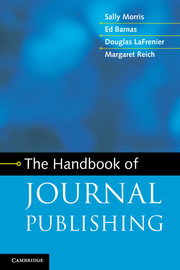Book contents
- Frontmatter
- Contents
- Preface and acknowledgments
- 1 Introduction to journals
- 2 Managing journals
- 3 Editing
- 4 The production process
- 5 Journal metrics
- 6 Marketing and sales
- 7 Fulfillment
- 8 Journal finances
- 9 Subsidiary income
- 10 Contract publishing
- 11 Copyright and other legal aspects
- 12 Ethical issues
- 13 The future of scholarly communication
- Appendix 1 Glossary
- Appendix 2 Resources
- Appendix 3 Vendors
- Index
- References
9 - Subsidiary income
Published online by Cambridge University Press: 05 March 2013
- Frontmatter
- Contents
- Preface and acknowledgments
- 1 Introduction to journals
- 2 Managing journals
- 3 Editing
- 4 The production process
- 5 Journal metrics
- 6 Marketing and sales
- 7 Fulfillment
- 8 Journal finances
- 9 Subsidiary income
- 10 Contract publishing
- 11 Copyright and other legal aspects
- 12 Ethical issues
- 13 The future of scholarly communication
- Appendix 1 Glossary
- Appendix 2 Resources
- Appendix 3 Vendors
- Index
- References
Summary
Introduction
We noted in the marketing chapter that journal publishers who rely primarily on institutional subscriptions and license fees need to develop other sources of revenue. This chapter will briefly survey some of these other revenue channels. Since consortia licensing arrangements draw on the same institutional serials budgets that pay for subscriptions, we will not dwell on them here. (Consortia licensing is covered in Chapter 6, Marketing and sales.) Some of these items do depend on the institutional market, but not, generally, on the library’s serials budget.
We make no attempt to rank these revenue channels by size or return on investment. Different publishers will have different results, depending on subject matter, the national or international character of the journal, real-world events, and the effectiveness of the publisher’s own marketing and publicity efforts. Suffice it to say that, for most journals, subscription and license revenue and/or OA publication fees will still probably constitute the major part of the publisher’s income.
Alternative modes of access
Subscriptions and license fees are not the only way to gain access to a publisher’s content, especially for those institutions or individuals who only need an occasional article, or who want to tap into a publisher’s content for a brief period of time (as a student doing a thesis might).
- Type
- Chapter
- Information
- The Handbook of Journal Publishing , pp. 270 - 296Publisher: Cambridge University PressPrint publication year: 2013

